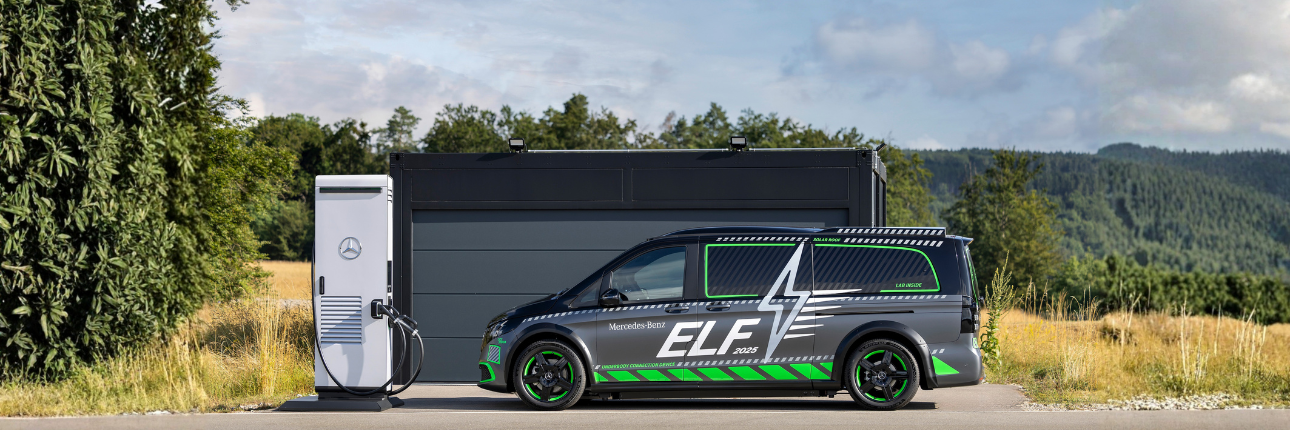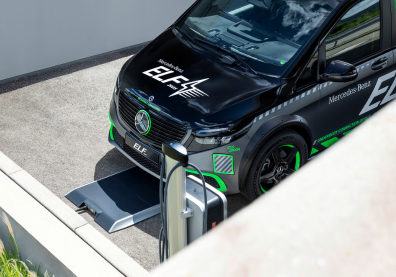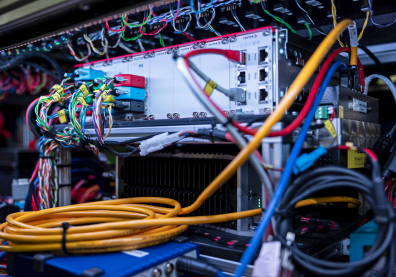We use cookies to make your experience better. To comply with the new e-Privacy directive, we need to ask for your consent to set the cookies. Learn more.


Mercedes-Benz ELF: a Novel Approach to Charging Electric Vehicles
With its focus on local CO₂-free driving, intelligent charging and holistic resource conservation, Mercedes-Benz is making the case for sustainable innovation with its ELF experimental charging vehicle.
A Seamless, Intelligent Charging Experience
“ELF” is the nickname derived from the German term Experimental-Lade-Fahrzeug – which translates to Experimental Charging Vehicle. Electric mobility is more than just technology – it stands for responsibility towards the environment, society and future generations. However, creating emission free driving isn’t enough, charging must also be efficient, intelligent and sustainable. That’s why Mercedes-Benz is constantly working on innovative charging solutions – whether that’s at home, at your workplace or public charging stations.
Back in 2021, Mercedes-Benz was one of the first manufacturers to launch a function to ensure fast-charging is easier than ever: “Plug & Charge” with MB.CHARGE Public [1] – a feature fully integrated into your electric vehicle. An integral part of this service is using Green Charging [2] in Europe, Canada and the U.S., which specifically promotes the use of electricity from renewable energies.
More Than Just a Vehicle
ELF is more than just a vehicle - it stands as a symbol towards a new era in charging and renewable energy. The mobile charging lab unites ultra-fast, bidirectional, solar, inductive and conductive charging in a holistic concept that doesn’t just test the limits of what’s possible but is helping to make them a reality. The ELF team is driven by dedication and innovation, working to make electric mobility more convenient, efficient, and sustainable. With ELF, Mercedes‑Benz is underlining its role as a pioneer in mobility and setting milestones in the charging of electric vehicles.

Fast Charging: At The Limits of What is Feasible
To ensure businesses and customers alike can seamlessly keep moving, fast charging is the key to the everyday usability of electric mobility. Mercedes‑Benz is exploring the limits of what is technically feasible – both within the vehicle itself and at the charging station. To this end, the experimental vehicle is equipped with two fast charging systems that cover different areas of application:
- MCS connector (Megawatt Charging System)
Originally developed for heavy-duty transport, this system allows charging capacities in the megawatt range. In the ELF, MCS serves as a research tool for testing the thermal resilience and performance limits of high-voltage batteries, power electronics, charging cables and other components under extreme conditions. The findings are being incorporated into the development of long-distance vehicles and fleet solutions with short downtimes.
- CCS connector (Combined Charging System)
CCS is used as the standard for passenger cars to test near-series components such as cables, connectors, cooling and charge control under everyday conditions. Mercedes-Benz is testing the technical limits of CCS to create the conditions for even higher charging capacities. The ELF can achieve a charging capacity of up to 900 kW. This means that 100 kWh can be charged in just 10 minutes. The vehicle simulates typical charging scenarios that occur in everyday customer use, such as at fast charging stations along motorways or in urban areas. The components used, such as the battery, charging control and CCS hardware, are already close to series production and will be incorporated into future Mercedes‑Benz models.
With the combination of MCS and CCS, Mercedes‑Benz is pursuing a dual research approach: on the one hand, new technological horizons are being explored, and the technology of the future is being developed. On the other hand, the series production readiness of existing systems and in turn, the charging experience of today is being improved.

Bidirectional Charging – Returning Energy; Shaping The Future
Bidirectional charging is a clear strategic lever for the energy transition. With the ELF, Mercedes‑Benz is exploring the full potential of this key technology: not only absorbing electricity but also feeding it into the home (Vehicle-to-Home; V2H), into the grid (Vehicle-to-Grid; V2G) or directly to electrical devices (Vehicle-to-Load; V2L). This allows electric vehicles to become an active part of a sustainable energy system. In the future, they will offer customers greater independence and potential cost savings. The ELF tests bidirectional charging in real-world scenarios. The findings are fed directly into the series development of future models.
The ELF is capable of both AC and DC bidirectional charging:
-
AC (alternating current) enables the power supply of electrical devices (V2L) and the return of energy via a bidirectional AC wallbox directly into the home network – for applications such as Vehicle-to-Home (V2H) or Vehicle-to-Building (V2B) or into the public power grid (V2G). An advantage is that the infrastructure is more cost-effective. A disadvantage is that standardisation becomes more complex as the vehicle must meet the requirements of different power grids.
-
DC (direct current) allows for direct energy recovery with a bidirectional DC wallbox into the public power grid (V2G) and directly into the home or building network (V2H; V2B), depending on the infrastructure used. An advantage is high efficiency, especially when using a hybrid inverter for bidirectional charging. With photovoltaics and home storage, it is easier to meet grid requirements. A possible disadvantage could be the slightly higher investment costs for the charging infrastructure.

General Customer Benefits of Bidirectional Charging
Bidirectional charging creates a new level of independence, cost-effectiveness and sustainability for customers:
-
Self-sufficiency & emergency power supply: a typical Mercedes‑Benz high-voltage battery in an electric vehicle with a capacity of 70–100 kWh can fully supply an average single-family household with electricity for two to four days (V2H) – ideal in the event of power outages or as a supplement to a photovoltaic system. In addition, the vehicle can also serve as a mobile power source for electrical devices via V2L (Vehicle-to-Load) and, for example, flexibly supply tools or household appliances with energy.
-
Reducing the carbon footprint: solar power is used in a targeted manner. Surplus solar power can be temporarily stored in the high-voltage battery for later use in the home (V2H). This helps to reduce CO₂ emissions.
-
Energy cost savings: In combination with intelligent energy management, electricity costs can be significantly reduced. Depending on the usage scenario, savings of around 500 euros per year are possible, which corresponds to approximately 10,000 free kilometres.
Electric vehicles are the key to moving toward a more sustainable future. With new technology and innovations, combined with further research into bidirectional charging, wireless conductive charging and conductive charging, a fully electric future isn’t far off thanks to the research produced by ELF and Mercedes-Benz.
For more information our electric model range currently available with Mercedes-Benz South West, keep in touch with our Sales team in Taunton, Exeter, Plymouth and Truro on 0330 818 4888.
